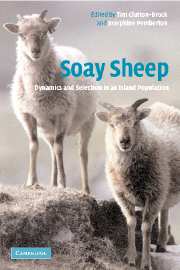Book contents
- Frontmatter
- Contents
- List of contributors
- Editors' and Authors' Acknowledgements
- 1 Individuals and populations
- 2 The sheep of St Kilda
- 3 Population dynamics in Soay sheep
- 4 Vegetation and sheep population dynamics
- 5 Parasites and their impact
- 6 Mating patterns and male breeding success
- 7 Selection on phenotype
- 8 Molecular genetic variation and selection on genotype
- 9 Adaptive reproductive strategies
- 10 The causes and consequences of instability
- Appendix 1 The flora of St Kilda
- Appendix 2 Inheritance of coat colour and horn type in Hirta Soay sheep
- Appendix 3 How average life tables can mislead
- References
- Index
- Plate section
4 - Vegetation and sheep population dynamics
Published online by Cambridge University Press: 07 December 2009
- Frontmatter
- Contents
- List of contributors
- Editors' and Authors' Acknowledgements
- 1 Individuals and populations
- 2 The sheep of St Kilda
- 3 Population dynamics in Soay sheep
- 4 Vegetation and sheep population dynamics
- 5 Parasites and their impact
- 6 Mating patterns and male breeding success
- 7 Selection on phenotype
- 8 Molecular genetic variation and selection on genotype
- 9 Adaptive reproductive strategies
- 10 The causes and consequences of instability
- Appendix 1 The flora of St Kilda
- Appendix 2 Inheritance of coat colour and horn type in Hirta Soay sheep
- Appendix 3 How average life tables can mislead
- References
- Index
- Plate section
Summary
Introduction
The relationship between the sheep and their food supply is a key element in understanding the population dynamics of Soay sheep on Hirta. This island population of Soay sheep provides an ideal model system for the study of plant–herbivore dynamics: there are no vertebrate predators like foxes or buzzards, and no competitors like rabbits or voles. The vegetation is relatively unpolluted by atmospheric nutrient inputs, there are no confounding management operations, and the population is closed to immigration or emigration. Because the sheep population is evidently food-limited, we expect that grazing will have a major impact on the biomass, spatial structure and botanical composition of the vegetation. In this chapter, we describe the relationship between the sheep and their food supply, and discuss the consequences of sheep grazing for plant performance and longer-term vegetation dynamics. In a plant–herbivore interaction where there are no competing herbivores and no vertebrate predators, we expect that herbivore numbers will be determined by the food supply available to the sheep during winter (Crawley 1983). Our study follows a long tradition of monitoring the response of vegetation to changes in the numbers of vertebrate herbivores: e.g. relaxation of rabbit grazing on chalk grasslands following the myxoma epidemic (Thomas 1960), African elephants (Cumming 1981), ungulate guilds in Serengeti (McNaughton 1985), introduced reindeer on South Georgia (Leader-Williams et al. 1987; Leader-Williams 1998), livestock in the New Forest (Putman et al. 1989) desert rodents in the USA (Brown and Heske 1990), moose on Isle Royale (McLaren and Peterson 1994), sheep on heather moorland (Welch and Scott 1995), lemmings in arctic tundra (Virtanen et al. 1997), whitetailed deer in North American forests (Cornett et al. 2000), kangaroos in Australia (Newsome et al. 2001) red deer on Rum (Virtanen et al. 2002) and many more.
- Type
- Chapter
- Information
- Soay SheepDynamics and Selection in an Island Population, pp. 89 - 112Publisher: Cambridge University PressPrint publication year: 2003
- 1
- Cited by

